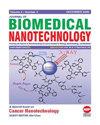In vitro and In vivo Characterization of Laurus nobilis Loaded Chitosan Nanoparticles as a Potential Treatment for Gastric Cancer Using SEM Images, PCR and Histopathology
IF 2.9
4区 医学
Q1 Medicine
引用次数: 0
Abstract
In the current study, Laurus nobilis extract (ethanolic) was loaded into chitosan nanoparticles and studied for their potential anticancer activity against GC1436 cells using SEM images of LNECHNPs and CHNPs. In vitro studies showed that gastric cancer cells cultured with the nanoparticle system suppressed the proliferation and migration activity of cancer cells through suppressing the PI3K/Akt/mTOR signaling pathway. The SEM images display that both LNECHNPs and CHNPs are round and possess a smooth surface. The smooth surface is a probable outcome of the manufacturing process used to create the nanoparticles, which can employ procedures like sol–gel or chemical reduction methods. Gene expression studies showed that the expression levels of PI3K and Akt genes were significantly reduced in GC1436 cells cultured with LNECHNPs Nephrotoxicity of the nanoparticles was studied in a rat model. In vivo study showed that the intravenous administration of the nanoparticle system did not impart significant nephrotoxicity in the animals 7 days post-injection. These results provide important insights into the safety of these nanocarrier systems, which could be beneficial in their potential application in biomedical and pharmaceutical fields.利用扫描电子显微镜图像、聚合酶链反应(PCR)和组织病理学分析壳聚糖载荷纳米粒子作为胃癌潜在治疗方法的体内外特性
本研究将月桂提取物(乙醇)载入壳聚糖纳米粒子,并利用 LNECHNPs 和 CHNPs 的扫描电镜图像研究了它们对 GC1436 细胞的潜在抗癌活性。体外研究表明,用纳米粒子系统培养的胃癌细胞通过抑制 PI3K/Akt/mTOR 信号通路,抑制了癌细胞的增殖和迁移活性。扫描电子显微镜图像显示,LNECHNPs 和 CHNPs 均为圆形,表面光滑。光滑的表面很可能是制造纳米粒子的生产工艺的结果,这种工艺可以采用溶胶凝胶法或化学还原法等程序。基因表达研究表明,在使用 LNECHNPs 培养的 GC1436 细胞中,PI3K 和 Akt 基因的表达水平明显降低 在大鼠模型中研究了纳米颗粒的肾毒性。体内研究表明,静脉注射纳米颗粒系统 7 天后不会对动物产生明显的肾毒性。这些结果为了解这些纳米载体系统的安全性提供了重要依据,有利于它们在生物医学和制药领域的潜在应用。
本文章由计算机程序翻译,如有差异,请以英文原文为准。
求助全文
约1分钟内获得全文
求助全文
来源期刊
CiteScore
4.30
自引率
17.20%
发文量
145
审稿时长
2.3 months
期刊介绍:
Information not localized
文献相关原料
| 公司名称 | 产品信息 | 采购帮参考价格 |
|---|

 求助内容:
求助内容: 应助结果提醒方式:
应助结果提醒方式:


